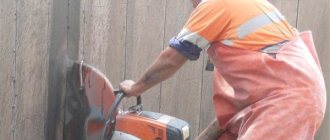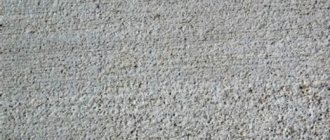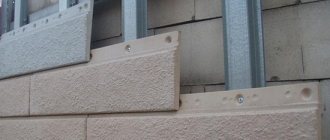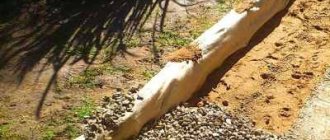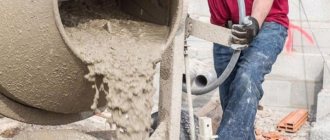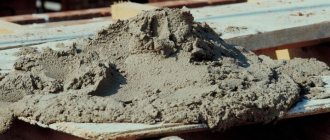Basic characteristics of concrete
The modern composition of concrete allows us to compare it with granite and marble - very resistant natural materials. This is due to the fact that manufacturers use modern technologies in the technological process. However, the appearance and structure of concrete is not so beautiful. Designers have learned to process its surface using the latest equipment, allowing it to be given unique shapes. The undoubted advantage of concrete in construction is its non-radioactivity. Before construction, you can prepare the solution yourself at home, or purchase it at a building materials store. Having decided to prepare a concrete solution yourself, you should find out the components and proportions of concrete in order to subsequently achieve good consistency and improved performance characteristics.
The photo shows concrete production
Structure and components of concrete
When making your own concrete solution, you need to know its components and their ratio. The solution is prepared in a specialized concrete mixing machine or in an ordinary barrel or tub.
Note!
The cement composition is the basis and main component in the entire mortar.
It consists of several components:
- limestone. As an ingredient, it reacts with water to form crystals that harden and give strength to concrete.
- a mixture of river sand and coarse gravel - general ballast. Experts recommend mixing the components three to one.
- special sand used in construction. This component occurs as a result of exposure to rivers, lakes and other water sources. Due to the fact that the size of these grains of sand is very small, they are round and smooth, this makes it easier to lay bricks and concrete slabs to the required level. The natural clay contained in construction sand provides viscosity to concrete prepared in the correct proportion.
- crushed stone formed as a result of crushing rocks. This component has a size of more than five millimeters.
Concrete video, concrete production video, operation of a concrete pump video
Concrete, video
which can be found everywhere on the Internet, is one of the most common building materials. There are a number of good reasons for this that are worth mentioning. First of all, it is a combination of high performance parameters and affordable cost. Even the most durable and reliable brands have an affordable price, which is quite a profitable and attractive moment when making a purchase. Do not forget that concrete, a video of which is available on the Internet, is produced in hundreds of factories in the Moscow region alone. Throughout Russia there are a huge number of specialized enterprises engaged in the production of this building material. If you do not have the necessary knowledge in this area, then before buying concrete, a video about this composition is recommended for viewing. There are a large number of videos where, in a few minutes, the main characteristics are determined, as well as their impact on operating efficiency and some other points. Thus, it becomes possible to quickly and effectively increase your level of knowledge about this material, which is very convenient.
Concrete, a video about which is everywhere on the Internet, you just need to type the relevant key queries, and has a reasonable cost. This has already been mentioned earlier and should be considered in more detail. Concrete, video
which is described on various sites, has a price that is made up of several factors. First of all, this includes the cost of all components. This is the decisive point. Water should not be taken into account, since the amount of its purchase is minimal and does not affect the overall price in any way. The amount of binder material has a much greater influence. Although its percentage ratio to the volume of concrete, the video of which has varying lengths, is small, the cost is quite high. Thus, the higher the grade, the more binder needs to be added. Accordingly, such concrete, videos about which are everywhere, are more expensive and this should be taken into account in order to invest in the established budget.
The strength of the material and its other performance characteristics are the decisive factor when choosing. They determine whether the composition is suitable for use in specific conditions. Each brand has its own characteristics and should be used in certain variants. The production of concrete, videos about which are everywhere, involves the introduction of special additives into the mixture at the mixing stage. They allow you to achieve effective and durable results. Typically, additives in concrete production, video
which should be reviewed, allow you to increase frost resistance or moisture protection factors. It should be said that these are not all options for using such substances. Supplements can provide a huge number of other benefits and this should be taken into account and the need for administration considered on a case-by-case basis. The production of concrete, a video about which is available on almost all specialized websites, is carried out independently or at the enterprise. Purchasing material from the factory is considered preferable and there are good reasons for this. First of all, they lie in the fact that the production of concrete, videos of which are everywhere, is carried out with strict adherence to all recipes and unconditional adherence to established technology. This allows you to achieve optimal operating parameters. They exactly correspond to those established in documents and state standards used in this area.
Concrete production, video
which is available online, can be done independently. This is a fairly popular option, since buying material from a factory involves some disadvantages and this should be taken into account. The production of concrete, a video about which explains in detail all stages of this process, is ensured by mixing all the components. It is worth saying a few words about conducting preliminary activities. It is impossible for the production of concrete, the video about which is quite informative, to be carried out without preparing the components. The filler should be thoroughly washed to remove foreign elements. The binder must be stored in a place so that it is not saturated with water absorbed from the air. Particular attention is paid to sand. This material is filtered through a sieve to prevent the formation of foreign components in the concrete structure. In general, such events do not take much time and the production of concrete, the video of which describes the process, is carried out quite quickly.
The production of concrete, a video about the implementation of a similar process is present on the Internet, must always be carried out with strict adherence to all instructions and directions. This approach allows us to guarantee that the result of the work will meet expectations. Compliance with proportions is carried out according to special documents. Each brand has its own standards, which is very important. The production of concrete, a video about which allows you to better understand the sequence of activities, implies the need to mix the components gradually. The simultaneous introduction of the entire volume of material will lead to very undesirable consequences. For example, this includes the occurrence of lumps or other inclusion inhomogeneities. Concrete production, video
which avoids a large number of problems during the mixing process, requires the use of special equipment. As practice shows, mixing yourself has a number of disadvantages. This includes the inability to thoroughly dissolve some inclusions. For example, the binder material is beaten into balls that contain a completely dry composition inside. The production of concrete, videos of which are everywhere, performed with a similar problem, is undesirable. Such a composition, after hardening into a monolithic mass, will have relatively low performance parameters. This is a serious problem because replacement structures have a significant cost. The production of concrete, videos of which are presented on various websites, must be carried out as efficiently as possible from the very beginning. This will ensure the necessary characteristics and durability for the entire structure, regardless of operating conditions, as well as other influencing factors.
Making concrete on site involves the use of mixers. These are special stationary machines with a special design. They are bowls of various sizes, rotating electrically or manually. Such concrete production, a video of which is available on the global network, contributes to the formation of a homogeneous mass. All components are mixed together and a number of problems disappear. Concrete production, video
and useful tips for the implementation of which we have on our website, performed in accordance with established requirements, will ensure successful manufacturing conditions. In any case, thoroughly mixing all the components and their gradual introduction is one of the basic rules for carrying out work.
If you are interested in the operation of the pump, the video can be seen by entering the corresponding query in search engines. You should take a closer look at this type of equipment, since it has become widely popular when it is necessary to perform various construction works. Any operation of the pump, a video of which is presented online, implies the need to pump the composition. It should be noted that this is not always possible, since the required conditions must be provided. Pump operation, video
which is available online, is carried out only if the mobility of the mixture has the required indicator. If the composition is closer in characteristics to a solid rather than a liquid, then certain problems will arise. The operating features simply do not allow transporting such material through pipes. When a pump is operating, a video of which is available on the Internet, the angle of inclination plays a significant role. If you tilt the pipe too high, gravity begins to work against the lifting forces. Thus, at a certain stage, the power of the equipment is simply not enough to ensure the upward transportation of the train. This is not only a negative effect, but also brings a number of significant problems. Thus, the operation of the pump, a video of which should be viewed on the Internet, should be carried out in cases where it is known in advance that the device will be able to function. This factor is crucial and should be taken into account during preparatory activities.
When the pump is running, the video gives you an idea of the process. Often, the equipment is installed on vehicles for transporting trains. This approach helps to solve a large number of problems arising in this area. Pump operation, video
which is available for various models of the unit, helps speed up the pouring of monolithic structures. Activities are carried out several times faster and this helps solve the problem of setting the composition.
Component ratio
When making concrete mortar at home, you must strictly follow the instructions of specialists. To obtain a homogeneous and unified structure, all the constituent ingredients of cement should be combined with water. When calculating the exact amount of liquid, it is important to take into account the characteristics of other materials used in construction. Each building material has individual absorbent abilities.
The preparation of concrete depends mainly on the correct construction mortar. It is often used in finishing and other construction work, and helps in the construction of brick walls. Today, the mortar includes binding components, usually cement and viscous clay, and a filling component. Sand taken from reservoirs, small wood shavings or waste slag are used as filler.
The photo shows the proportions for preparing concrete
TYPES OF CONCRETE AND PURPOSE
The industry produces several types of concrete, which are in great demand among builders, architects and designers.
REINFORCED CONCRETE
— reinforced concrete of various grades. It is used in all climatic zones and does not lose its properties in the temperature range from -45 to +60°C. Applicable
in capital construction.
SILICATE CONCRETE
- a mixture of lime and silicon. The composition may also contain quartz and silica. The filler is sand.
It is treated in an autoclave with steam at a temperature of +174…+198°C.
ASPHALT CONCRETE
is in particular demand among road workers and builders of multi-storey buildings. This is a dense mixture of bitumen, crushed stone and mineral powder. Before mixing, each component is heated to +150°C. Asphalt concrete is divided according to the type of laying: hot or viscous - temperature +120°C; warm or low-viscosity - laying temperature +40...+80°C; the third type - cold or liquid - must have a temperature of at least +10°C.
HYDRAULIC CONCRETE
has increased water resistance. It is used for structures that are constantly in contact with water, such as hydroelectric power plants or bridge supports.
Expanded clay concrete
belongs to the class of lightweight concrete. The main filler in it is expanded clay. Building elements made from this concrete significantly reduce not only the weight of the building, but also its cost.
PERLITE CONCRETE
- another type of lightweight concrete. The main filler in it is perlite. Mainly used for decorative concrete fences.
TUFF CONCRETE
. The filler is volcanic tuff. Walls and floor slabs are built from this material.
GYPSUM CONCRETE
used for interior work in buildings and structures. Instead of cement, building gypsum is used, to which a stone filler is added in combination with wood or straw. The main disadvantage is that it dissolves in water.
PLASTIC CONCRETE
used for flooring in industrial and public buildings. Instead of cement, an organic polymer is used as a binding component. The filler can be any sand.
A number of concretes, in addition to their direct functions, have thermal insulation qualities. These include cellular concrete. They are divided into two types - gas and foam concrete. The demand for such concrete is increasing every year due to the increase in the cost of all types of utilities, including tariffs for electricity and gas in civil and industrial buildings.
CELLULAR CONCRETE is an artificial stone material based on mineral binders and a silica component with pores evenly distributed throughout the volume. Depending on the purpose in construction and production technology, cement, lime, gypsum or their composition can be used as a binder filler, and sand or ash from a thermal power plant can be used as dispersed filler. Depending on the manufacturing technology, a distinction is made between FOAM CONCRETE and aerated concrete .
In foam concrete, pores are formed due to the introduction of foaming agents, and in aerated concrete - due to substances that release gas during chemical reactions. Powdered aluminum is usually used for this purpose. During the reaction between aluminum metal and alkali, hydrogen is released, which porosizes the mixture.
Aerated concrete has become one of the leaders among building materials due to the air it contains. Walls built from aerated blocks are an effective barrier not only to cold, but also to heat, and this is an important advantage of this building material.
Link by topic: Do-it-yourself aerated concrete walls
According to purpose, aerated concrete is divided into:
- thermal insulation - density 200-500 kg/m3;
- structural and thermal insulation, 500-900 kg/m3;
- structural, 1,000-1,200 kg/m3.
Producing foam concrete, unlike aerated concrete, is a less energy-intensive non-autoclave technology.
During the manufacturing process, it is easy to give this material the required density by dosing the supply of foaming agent. It is possible to obtain products with a density from 200 kg/m3 to the most extreme values of lightweight concrete - 1,200-1,500 kg/m3.
WHITE CEMENT
Giving high decorative qualities to concrete largely depends on the type of cement used. In construction and finishing practice, a special role is given to white cement, which does not absorb color.
The surface of structures made on the basis of white cement does not darken or lose its reflective ability when exposed to rain and snow (no more than 5%). White cement has become a major component in a variety of building materials - mosaic tiles, white and colored exterior mortars, ceilings, pool tiles and garden paths. In addition to its high strength, this cement has a low alkali and aluminate content, which contributes to its resistance to chemical attack, efflorescence and stains commonly encountered in construction.
Proportions for making concrete
The most common proportion of components is:
- One unit of cement
- Three units of river sand
- Six units of additional filler.
In order to achieve a certain thickness of the solution, you need to know how to mix concrete.
Note!
If you need a thinner solution, it is recommended to add half or one part water to it.
However, in order to obtain concrete with the best possible structure that meets all state quality standards, special attention is paid to the exact proportions of the ingredients. The main factor in this is the density and basic characteristics of the cement mortar, the filling material used and the sand.
The photo shows how to make concrete
This is interesting! Concrete calculation
Additional additives to concrete
To improve the quality and performance characteristics, the concrete solution is mixed with modern additives and components that are widespread in the building materials market. Creating concrete at home depends on a number of factors; what characteristics need to be improved can be added to it:
- plasticizers. They are used to make concrete with your own hands convenient and have plasticity for easy laying.
- hydraulic seals. This component is an insulator against excess moisture.
- Dust removers. They strengthen the concrete, preventing it from abrasion and cracking in the future.
- accelerators or retarders of the hardening of the solution regulate the hardening time.
- frost-resistant additives.
Before purchasing the necessary additives, you should pay attention to their characteristics. This is due to the fact that some components can have a complex effect on the solution. However, some additives do not combine with each other, so you should be sure to read the instructions for them before purchasing.
Mixing process
[rek_custom1]
This is interesting! How much does a cube of concrete weigh: the main types of this material, their characteristics and weight
Types of elastomer concrete
In practice, several types of material are used, differing in properties and nature of action: • plasticizers; • anti-frost; • modifiers; • retarders; • hardeners; • substances for self-leveling surfaces.
Elastic properties are imparted to the cement composition by special additives - plasticizers. They are based on polymer components that are added to dry mixtures and liquid concrete solutions. This is done in order to obtain the desired fluidity, moisture absorption, and plasticity. At the same time, they should be odorless, mix well with the main substance - cement, be resistant to solvents, and have a minimum level of volatility.
Important! Plasticizers increase the strength of cement mortar after its final hardening. In addition to providing elasticity, they reduce the mass of the solution. For example, a floor with such a concrete screed weighs less. Consequently, the load on the supports is also reduced.
Tools and options for making concrete
The most common option for where and how to mix concrete is various concrete mixers. By manually mixing in a bucket or barrel, it is impossible to achieve complete stirring of the solution to a homogeneous state. At the same time, at home it is problematic to stir large volumes of solution, for example, to fill a foundation. When making concrete with your own hands, two options are used:
- Initially, all the dry ingredients are combined, stirred and only then gradually filled with water. In this case, the materials are distributed fairly evenly, but manual mixing and gradual addition of water does not guarantee complete and rapid wetting of all components. In this regard, undissolved materials in dry form may remain at the bottom of the barrel, and, consequently, the proportions of making the solution are violated and the concrete turns out to be of poor quality.
- The second option involves pouring the dry ingredients into already prepared and measured water. Then it is recommended to stir the solution for a long time so that the cement can adhere to other fillers and components.
Ready concrete
This is interesting! Calculation of cement mortar
Self-healing elastic concrete
A new type of concrete has been created in the Netherlands that can “heal” itself with the help of bacterial microorganisms that produce calcareous materials. Its principle of operation is to lay capsules with bacteria in a state of suspended animation during the formation of the solution. If the structure is damaged and moisture penetrates into it, the capsules are destroyed, and the bacteria awaken under the influence of the liquid. The nutrient medium allows them to live and produce a lime mixture that seals cracks, restoring the integrity of the structure.
When solving the problem of creating “self-healing” concrete, it was necessary to resolve issues related to bacteria: 1. Find a species that can survive in an aggressive alkaline environment; 2. Ensure their long-term preservation; 3. The ability to activate under favorable conditions.
The scientists chose bacilli from the rod-shaped genus, which form intracellular spores. For them, living in alkali is normal, as is hibernating for a long time. After activation, they need a nutrient medium. Sugar was not suitable for this purpose because it makes the concrete loose. We settled on calcium lactate - calcium salt of lactic acid (food additive E327). The capsule is a synthetic substance that decomposes under the influence of natural factors.
Now scientists are working on nature-like materials that are used not only in the construction industry, but also in information and computer systems.
Mixing concrete
Conventional standard concrete mixers are designed for 200 liters of ready-made solution. Accordingly, all proportions and ratios of components will be calculated from this quantity. How to make and mix concrete correctly:
- Initially, a measured portion of water is poured into the mixer. About 20 percent is saved in case it is added later.
- The cement composition is poured into the water.
- After adding sand, mix everything well until all components are evenly distributed, about 5 minutes.
- After mixing, the necessary additional components are added to the finished cement mortar to enhance certain characteristics of the concrete.
- The last thing to be poured into the concrete mixer is aggregate in the form of crushed stone or coarse gravel.
The entire process of mixing concrete should take place for 10 minutes, until the solution begins to harden and delaminate.
The sponsor of this material is a company that sells vibrating screens for crushed stone.
The invention of flexible concrete ConFlexPave
Structured water is a term in esoteric texts used to designate a certain “water with a structure changed relative to its equilibrium with the environment” and is proposed as a “super-means” capable of supposedly changing something there. Many chemical reactions with ice proceed more slowly than with liquid water, due to the lower temperature of ice compared to liquid water. Similar chemical reactions with steam, accordingly, will proceed faster than with liquid water. The influence of structures in liquid water is extremely insignificant and is never taken into account during experiments; only the existence of the effect of ordering of water molecules has been proven during the adsorption of water molecules on surfaces that have a specific alternation of positively and negatively charged groups of atoms, as well as during the dissolution of some polymers, in particular protein macromolecules, which is used to describe cellular fluid. This ordering is neither complete throughout the entire volume of the liquid nor stable over time. Such a structure is destroyed within a short time on its own due to the thermal movement of water molecules and is completely destroyed when a disturbance is introduced into the structured medium (for example, during stirring). Coherent long-range dipole-dipole interactions of subpicosecond duration at distances up to 2 nm, similar to those observed in ice, have been found in water. Complete ordering of water into a stable structure (the emergence of long-range order) occurs when it freezes, but this structure is almost completely destroyed when frozen water thaws - small groups of molecules with “short-range order”, reminiscent of the order of ice molecules, remain in the liquid phase. This is confirmed by X-ray diffraction analysis. However, when shaken or heated to 30 °C (for example, if you drink it), the water becomes completely amorphous. This effect is characteristic not only of water, but also of other substances near the melting point; back in the 60s, it was discovered that a melt of single-crystalline germanium retains the molecular structure of the single crystal for some time and, upon cooling, single-crystalline germanium is more likely to form. If the melt is stirred or heated more strongly, then after cooling germanium with a polycrystalline structure is formed. References to “water memory” in relation to the use of aqueous solutions for the treatment of diseases currently have no scientific basis. The theory of the cluster structure of water was refuted both theoretically in the early 80s by the application of percolation theory, and experimentally by measuring the lifetime of intermolecular hydrogen bonds in picoseconds.

